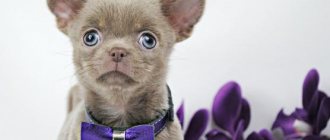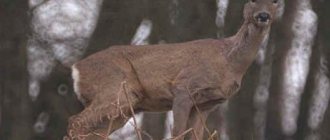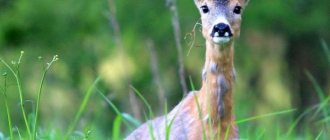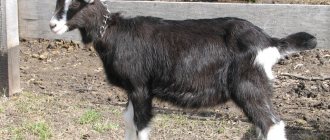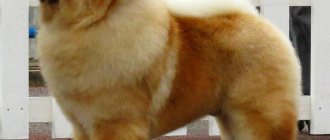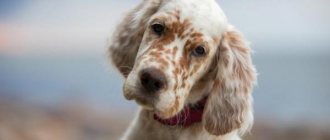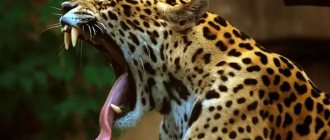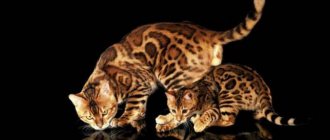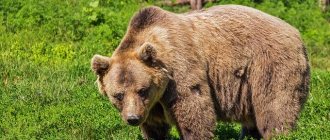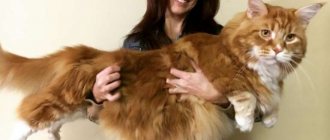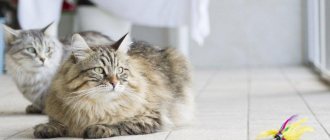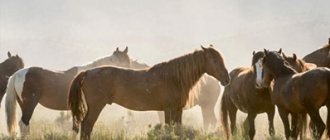- Wild animals
- >>
- Mammals
The Siberian roe deer is a fragile, small fallow deer. It has many names. The most common is eastern. The roe deer is considered the largest in the category of the smallest deer. Nature has endowed this animal with incredible grace, fragility and caution. Habits and lifestyle have a lot in common with goats. The European roe deer is considered its closest relative.
Origin of the species and description
Photo: Siberian roe deer
The Siberian roe deer is a herbivore, artiodactyl mammal. Belongs to the deer family, the roe deer genus. The ancient ancestors of the genus are the Miocene Munjacs. Scientists note that in the Upper Miocene and Lower Pliocene, throughout Europe and Asia, a group of animals lived that had many common characteristics with modern roe deer. Until recently, Siberian roe deer lived throughout the temperate climate.
Capricorns
Capricorns are distinguished by the incredible shape of their horns, very reminiscent of a saber. The appearance is very reminiscent of mountain aurochs. First of all, they include the Alpine ibex or, as it is also called, Ibeymacotecomicotecotecotecotecothec. Capricorns also include Siberian, Nubian and Pyrenean mountain goats. There are a lot of Capricorns in nature, they reproduce easily and cross well with other breeds.
Capricorns in general are slightly smaller than Caucasian Turs. The color is sandy, with a brown tint. Males have a thick beard. Most often they can be found in Afghanistan, Russia and India.
Unlike the Caucasian type, Capricorns love solitude. Sometimes males form pairs, but often live in splendid isolation.
These mountain animals are incredibly beautiful and even in captivity they have a luxurious, noble look.
The mountain wild goat still lives in the highlands today. Its relative is the domestic goat. Wild animals do not graze on the open plain.
Appearance and features
Photo: Female Siberian roe deer
The body length of this representative of the deer family does not exceed one and a half meters. Body height at the withers is 80-95 centimeters. The body weight of an adult is 30–45 kilograms. Males are slightly larger than females, but this is not pronounced.
Roe deer have a small, somewhat elongated muzzle. The size of the skull does not exceed 20-22 centimeters. There are high horns on the head, the length of which in some cases reaches half a meter. The horns are most often wide and spreading. Only males have long beautiful horns. Females do not have them at all, or have small, unattractive horns.
Video: Siberian roe deer
The coat in winter is thick with a reddish tint. In spring and summer, the gray color of the hairline predominates, while the white mirror in the tail area becomes the same color as the entire body. The fur sheds twice a year. In summer, the coat is significantly thinner and shorter. Females and males have the same coloration.
There are oblong, rounded ears on the head. The roe deer is distinguished by its huge black eyes with slanted pupils. The animal has a long, graceful neck without a mane. In males it is stronger and stockier than in females. Siberian roe deer have long, slender limbs. The forelimbs are somewhat shorter than the hind limbs. Because of this, the spine is slightly tilted forward. There is a small round tail that is surrounded by a ring of white fur called the speculum.
In the spring-summer period, males have very developed secretory glands, in particular, sebaceous and sweat glands. With their help, males leave marks indicating that they belong to a certain territory. Siberian roe deer have excellent, highly developed hearing and sense of smell.
Features of behavior in natural conditions
If Siberian goats are hunted in their habitats, they become very shy and cautious. However, if there is no danger from a person and he does not hunt them, these goats can allow people to get quite close to them, and sometimes even begin to graze with domestic animals.
Excellent eyesight, as well as excellent sense of smell and hearing, allow mountain goats to respond in a timely manner to changes in the environment.
If one of them smells something that looks like a dangerous object, he can, without looking up. monitor the potential source of threat for about half an hour.
In normal circumstances, sounds from these animals are heard extremely rarely. Most often this is a whistle, which means a signal of a potential threat. But during the rutting season, the males roar deafeningly. The sounds that females and small kids sometimes make are very similar to the bleating of domestic goats, except that the timbre is more dull.
Both bucks and goats of this variety of wild animals have horns, which are much smaller in females and curve slightly back.
Where does the Siberian roe deer live?
Photo: Siberian roe deer Red Book
The habitat is quite wide.
Habitat area of the Siberian roe deer:
- Northern regions of Mongolia;
- Western Territory of China;
- Middle Asia;
- Yakutia;
- Transbaikalia;
- Siberia;
- Ural.
In the old days, the ancestors of this species of artiodactyls chose forest-steppe territory for their habitat. However, with the expansion of the borders of human-developed territories, they moved into the forests. Roe deer choose as their habitat areas where they can easily hide and find food easily. If there are no problems with food, but there is difficulty with shelter, the animal will not stay here. This is explained by the development of the instinct of self-preservation.
Roe deer, living in open areas unprotected by dense vegetation, are easy prey for predators.
They prefer the foothills of mountain peaks, rocky terrain, tall bushes, and the shores of steppe reservoirs. In addition, these fragile animals love meadows and tall, thick grass. You can often find Siberian roe deer in swampy areas, coniferous and deciduous forests, and on agricultural land. They have excellent ability to adapt to cultivated areas. It should be noted that these seemingly gentle animals tolerate cold and persistent frosts very well.
The choice of settlement location is influenced by several main factors: the availability of a food source, shelter and the depth of the snow cover. The maximum permissible height of the snow layer is 0.5 meters. If the height exceeds this mark, the artiodactyls look for another place where the snow cover is significantly less. Another important condition is that there is no snow on the ground for most of the year.
What zone does it live in?
The Siberian mountain goat lives in Russia, China, Afghanistan, Kyrgyzstan, Uzbekistan, Kazakhstan, India, and Pakistan. In Russia they live mainly in Southern Siberia. The main number of heads is found in Altai in the Argut River basin. Mountain goats were also discovered in the territory from the right bank of the Yenisei to Lake Baikal - in the Eastern Sayan.
Representatives of this species choose rocky areas and mountains as a home. They can also settle within the forest zone, but this happens quite rarely. Another favorite place of Siberian mountain goats is the forbs of alpine meadows. In winter, they find the least snowy places to live. This is explained by the fact that under their weight they fall heavily into the snowdrifts, which is why they become helpless.
What does the Siberian roe deer eat?
Photo: Male Siberian roe deer
Siberian roe deer are herbivores. However, it cannot be said that they feed only on grass. Animals can eat mushrooms, berries, young shoots, and leaves. In early spring, they eat the budding buds on trees. They prefer juicy, fresh greens. They can feed on dry vegetation and cereals when there is a lack of food.
In order for the body to receive the necessary minerals, roe deer eat salt licks or look for water sources that are enriched with minerals for watering. During the period of bearing and feeding cubs, the need for minerals increases several times.
The most difficult period for the Siberian roe deer is the end of winter. It is at this time that they feel an acute lack of mineral-rich food, as well as fluid. When bodies of water freeze, they can eat snow to replenish the body's fluid needs. In winter, in the absence of food, they can eat coniferous trees.
The digestive system of artiodactyls has a small stomach. Because of this, roe deer eat little. However, an active metabolism requires frequent food intake. During the day, one adult individual has at least 7-10 meals. The daily food intake for one individual is determined by its body weight and is approximately 2-2.5 kilograms of green vegetation. During the cold season, the daily amount of food decreases, as does its calorie content.
In conditions of food shortages, fierce competition grows between other representatives of ungulates and Siberian roe deer. In winter, in the absence of a food source, roe deer dig up snow with their hooves, digging out dry vegetation. They are able to get their food from under layers of snow, the thickness of which reaches half a meter.
Diet
In summer, the basis of the nutritional diet of these animals is herbaceous plants. In autumn, they mainly feed on cereals and forbs, which grow abundantly on the slopes of the fescue steppe. At the same time, goats willingly eat tree and branch food, such as leaves and young shoots of currants, rose hips, willow and rowan.
The winter diet mainly consists of dried grass, which they extract from under shallow snow or find between stones on snowless rocky slopes.
Features of character and lifestyle
Photo: Siberian roe deer
These animals exhibit a cyclical pattern of daily activities. They alternate periods of grazing and movement with chewing food and resting and sleeping. Animals are most active and mobile in the early morning. Animals spend most of their time lying down. The beds are platforms that they clear of snow and dry vegetation with their hooves. Typically, Siberian roe deer choose places for bedding on the outskirts of clearings, or in forests.
By nature, Siberian roe deer are not solitary animals. They gather in small groups of 7-12 individuals. The group consists of a male, several females and young animals. In the cold season, small groups can unite into a herd, forming up to three dozen animals. With the onset of spring they disintegrate again.
Daily activity depends on several factors: seasonality, the number of individuals in the flock, the severity of anthropogenic pressure. In winter, the highest activity is observed in the early morning, in summer - at night and in the evening. With pronounced anthropogenic pressure, the greatest activity of individuals also occurs in the dark.
Siberian roe deer are tied to a specific habitat. Having mastered a certain territory, they tend to return there again and again. Males cover a certain territory, which they mark by rubbing their forehead and neck against trees. They can also dig the ground with their hooves, leaving a secretion between the toe glands. One adult male occupies a territory of 20 to 150 hectares. As a rule, the possessions of males do not overlap. Layering of sections on top of each other is possible only at high density.
It is unusual for males to enter other people's territories. With the onset of each new season, adult males win back their right to own territory.
Siberian roe deer are considered peace-loving, non-conflict animals. Even between males, conflicts rarely arise. When a controversial situation arises, they tend to demonstrate strength in front of their opponent. Roe deer make many different sounds.
Typical sound signals of Siberian roe deer:
- Whistling. It is typical when a female communicates with her cubs. It is a manifestation of restlessness and anxiety.
- Hissing, snorting. Expresses aggression and irritation.
- Barking. Can be emitted by disturbed, frightened individuals.
- Moan. Sounds from an animal that is trapped.
- Noisy jumping, clattering hooves. It is a characteristic sign of a feeling of danger, fear.
In the communication of individuals with each other, nonverbal language of postures plays an important role. Thus, they give each other alarm signals, calls to escape, etc. Roe deer tend to run fast and jump high. In an attempt to escape from being chased, Siberian roe deer jump more than five meters in height.
Wild chamois
She belongs to the bovids. This animal can reach 135 centimeters in length and up to 80 in height. The weight of females can reach 40 kilograms, and males - 60. They have a short, almost invisible tail. The distinctive features of the chamois are:
- Backcurved horns;
- Pointed ears;
- Short muzzle;
- The legs are strong, thin and long;
- In winter they are light gray in color, and in summer they are brown;
- There are black stripes near the eyes;
- Along the ridge there is a solid black stripe.
Where do they live?
Chamois live in southern Europe and its central part, the Pyrenees. In the wild they can be found in the Caucasus and Turkey. They have adapted well to life in mountainous areas, where there are a lot of screes and stones. Throughout the summer, they live on meadow slopes located slightly above the line in the mountains of forests at altitudes of 3.6 kilometers. When food becomes scarcer in winter , they can descend to a height of 0.8 kilometers.
But they prefer to stay in the forests. These animals are also common in New Zealand. Today they are of particular hunting interest to New Zealanders.
Chamois nutrition and lifestyle
Chamois live in a herd. Their number in it can vary from 20 to 100 pieces. There are no males in the herd. There are only cubs with their mothers. Males live separately throughout the year. Their lifestyle is called hermitic. They breed between late November and early December. At this time, the male becomes aggressive and enters into battle for the female. The fighting is very fierce. There are also deaths of one of the participants.
They feed on all the vegetation they can get their hands on. In summer there is an abundance of young shoots and grasses, and in winter there is the bark of young trees and pine needles.
Animals rest during the daytime and are active at night. If you have to save your life from a predator, the chamois can reach a speed of 50 kilometers in 1 hour. If it is necessary to break away from pursuit, the chamois is capable of jumping up to 2 meters in height and 6 meters in length. The main enemies and predators are the wolf and the Iberian lynx. Today there are approximately 400 thousand chamois in Europe.
Reproduction of chamois
This period begins in late November or early December. The average length of pregnancy is 170 days. After this period, 1 kid is born. Very rarely the number of babies can reach 2 or 3 pieces. The average weight of a baby is 3 kilograms. The baby is constantly close to his mother. Breastfeeding ends after approximately 6 months. After this, the small chamois begins to eat food familiar to this species. If the mother dies and does not have time to feed the baby, then other females in the herd will take care of it.
Males live with their mother until the age of 3 years. After this, they gather in separate herds and live like this until they reach full sexual maturity . It occurs at approximately 8 years of age. Upon reaching this age, each male occupies a territory for himself and defends it with particular scrupulousness and persistence.
Females reach maturity at the age of 3 years. During this period, they can already reproduce. These horned animals live approximately 15 - 17 years. With proper care in captivity, they can live up to 23 years.
Social structure and reproduction
Photo: Siberian roe deer calf
The mating season for animals begins in mid-July and lasts one and a half to two months. Males are constantly looking for females; they eat practically nothing during this period. Females who have reached the age of two are considered sexually mature. If there are several contenders for the right to enter into mating relations with females, males may fight with each other.
There is also a manifestation of aggressiveness of males towards females. In one mating season, a male is able to fertilize up to 5-7 females. Female roe deer are also not distinguished by the formation of established connections. Although sometimes they can mate for several years in a row with the male they like best.
Latent pregnancy is observed in Siberian artiodactyls. That is, the resulting embryo stops growth and development for up to 3-4 months. If mating occurs in the fall, there is no latent period of pregnancy. As the embryo begins to grow, the female becomes more careful and careful. She is not characterized by sharp, dangerous jumps or too fast running. The gestation period is milked from 250 to 320 days. From one to three babies are born.
Roe deer cubs are very vulnerable and helpless. The female hides them in reliable shelters for several months.
The spots on the back help camouflage in thickets of vegetation. The mother is not far away, but prefers to feed and rest not with the babies, so as not to attract attention to them. The female maintains contact with the offspring until the emergence of a new generation.
Siberian roe deer have high fertility. With the onset of each new season, more than 96% of sexually mature female individuals of the species give birth. Despite high fertility, natural growth does not increase at a rapid pace. Among this species of ungulates, there is a low survival rate of cubs.
Features of life on the rocks
Animals do not move long distances from the slopes. On flat terrain, goats are clumsy, only the proximity of rocks saves them from danger and weather conditions. These “climbers” have the ability to climb steep peaks with lightning speed or make dizzying jumps down.
When everything is calm and there is no danger, the herd moves carefree in a chain. But at the slightest fright or alarm signal, the animals scatter in different directions. Moving along rock embankments is risky, as there is a danger of collapse. But the goats jump over them with ease. If the rocks begin to crumble, the animals slow down or freeze in place. A more serious problem is avalanches.
Due to the need to regularly and hastily move over rocky surfaces, Siberian goats have soft and continuously growing hoof pads. Therefore, with their feet they seem to stick to the surface of slippery rocks and run along cliffs inaccessible to predators. The main danger is leopards and wolves.
Natural enemies of Siberian roe deer
Photo: Siberian roe deer
The natural enemies of the Siberian roe deer are considered to be predatory animals. These include bears, lynxes, wolves, tigers. Foxes and predatory bird species pose a threat to young animals and helpless offspring.
Its small stature and natural gray-brown hair color allows it to blend in with the background of bushes, foliage and tall vegetation. Long legs allow you to run fast and overcome high obstacles. At the time of pursuit, adult roe deer reach speeds of up to 50 km/h. At this speed, they are not able to cover long distances. However, the ability to make similar jerks and jump up to 4-7 meters in height allows you to evade pursuit.
Another dangerous enemy of the Siberian roe deer is humans. It is thanks to the fact that people are actively destroying the natural habitat of these fragile animals, as well as hunting and poaching, that they are on the verge of extinction. The Siberian roe deer is a favorite trophy of hunters and poachers. Large, weighty antlers, skin and tender meat are always in demand and highly valued.
Typology of mountain goats
There are several types of mountain goats, which, in turn, are divided into 3 groups:
Their main difference is the appearance of the horns, and a common feature is their internal cavities are infinite.
Capricorns
In young individuals, the horns are typically curved like an arc, and this, in turn, after a certain period of time, as the goat grows older, begins to turn into a spiral. The largest group of Capricorns has a wide and saber-shaped group of Capricorns has To this group of groups:
- Siberian mountain goat,
- Nubian goat,
- pyrenees mountain goat,
- Ibex or Alpine ibex, or common ibex.
The latter species lives in the Italian Alps and in one of the regions of the Swiss Alps. It was smuggled there at the beginning of the 20th century.
Each of these species has its own 10 subspecies: 4 each of the Siberian and Iberian goats, 2 of the Usogebeke, 2 of the Ukagebete.
What do Capricorns look like?
Despite the fact that these species are directly related, the subspecies, however, have some differences that relate not only to their habitat. For example, Ibex are distinguished by the following characteristics:
- thick and long arched horns, diverging in different directions (in females they look like small, slightly curved graceful horns),
- the presence of a short beard in individuals of both sexes,
- ),
- The average body length is no more than 150 cm, height up to 90 cm.
- The weight of females is usually 40 kg, the weight of males can reach up to 100 kg.
Externally, Nubian goats look like this:
- horns - long and thin, curved back and down, size in males up to one meter, in komnekekebeke 30
- The color is yellowish-brown, identical to the color of the habitat (northeast Africa, the mountains and rocks of Arabia and Ethiopia), in August the color can change, from dark brown to basic black.
- A characteristic feature of Nubian goats (usually males) is a dark stripe on the back.
- the weight of goats is approximately 26.5 kg, goats are three times heavier - up to 62.5 kg.
- body length of Nubian goats is 105 and 125 cm,
- body height - from 65 to 75 cm in males and females.
The Iberian goat has a characteristic shape of horns: they are slightly curved, upward and inward.
The Siberian mountain goat can be recognized by the following characteristics:
- massive horns, very curved back, more than one meter long,
- the beard is more clearly defined than in other species,
- The coat color depends on the season, but always has a brown base.
- The neck and back of male Siberian goats may be covered with characteristic white spots.
- the height of Siberian goats is 67 - 110 cm,
- animal weight 35 - 130 kg.,
- body length - 130 - 165 cm.
Tour characteristics
The group of mountain goats called "represented" is mainly represented by one Western Caucasian species, which has three subspecies, the list of which often differs in different sources.
For example, the TSB (Great Soviet Encyclopedia) used the names “Kuban tur” and “Turtsova” as synonyms to name the main species, but at the same time, as a subspecies, the so-called “Güldenstedt tur” (or “Central Caucasian tur”) was identified.
— Therefore, here we will take as a basis the division of tours into subspecies, which is undoubted for all classes:
).
Their common external feature is curved horns in the form of a wide spiral, which are transverse. However, these subspecies differ from each other in the nature of the curvature of the horns and their direction.
However, we can say that there are other differences between these subspecies - genegospekichekimikikimekimekik And scientists have long noted with alarm that their mating with each other leads to the appearance of infertility. The International Red Book assigned the status of “endangered” to the Western Caucasian tur, and “close to threatening” to the Eastern Caucasian tur.
Mountain goats as they are
The group called “goats” has two types -
- horned goat (markhora),
- domesticated mountain goat (subspecies - bezoar goat, its ancestor).
Also, in turn, markhor has three subspecies, which differ from each other only in small features of the structure of the horns and habitat.
It lives in the mountains of Tajikistan, Little Tibet, Western Himalayas, Kashmir and Afghanistan. It is characterized by:
- helical horns that reach 0.5 - 1 m in length,
- a long black-brown beard (dewlap), which, as it becomes lighter, becomes a hanging mane.
- head and legs are dark in color,
- belly is light in color,
- body length - up to 1.5 -1.7 meters,
- tail length - up to 17-18 cm,
- height - no more than 90 cm,
- weight - no more than 90 kg,
- reddish-gray coat color, becoming dirty white over time.
The domestic goat usually has laterally compressed horns that form a sharp leading edge.
The protruding rib of the horn is not as clearly distinguished as in other groups, while some individuals may be. General characteristics cannot be established, since there are a large number of domesticated goats that differ in coat color, size, etc.
The most recognizable, as a rule, is the bezoar goat, which lives in Afghanistan, the Caucasus, Balochistan, Persia and Asia Minor and on some Mediterranean islands. It is characterized by the following symptoms:
- strongly curved horns with converging tips that are arched back,
- physique - stocky, legs - strong, with wide hooves,
- - long, its color in males, just like in many, depends on: in winter it has a silvery-white body, the chest and part of the season the muzzle are black-brown, in summer it acquires a red tint, in females it has yellowish-brown fur,
- characteristic two stripes: one along the back, the second from chest to back, in females there is one such stripe,
- tail - black, approximately 12 cm,
- body length - about 1.5 m, occasionally there are individuals 1.2 -1.6 m,
- weight depends on gender and age and ranges from 25 kg to 95,
- height - 0.7-1 m.
Despite its rather extensive habitat, the bezoar goat is also listed in the Red Book.
Excellent adaptability to life in hard-to-reach mountain rocks, cliff slopes and gorges. These are unique climbers!
Population and species status
Photo: Female Siberian roe deer
There are some regions in whose Red Book it is listed. On the territory of the Russian Federation, the Siberian roe deer is listed in the Red Book of the Tomsk Region and Krasnoyarsk Territory. They have been given the status of a declining population.
In general, today the species is not in danger of extinction. Thanks to captive breeding in large numbers, there are about 10-13 million individuals in the center of Europe. Although just two or two and a half decades ago their numbers were more than half as large.
High fertility allows populations to quickly recover. In some regions, hunting for Siberian roe deer is even allowed after purchasing a license. In Central Asian countries, roe deer meat is considered a great delicacy due to its nutritional value.
Links[edit]
- ^ a b c d Weinberg, P. and Ambarley, H. (2020). » Capra aegagrus » . IUCN Red List of Threatened Species
.
2020
: e.T3786A22145942. Retrieved July 10, 2022.CS1 maint: uses the authors parameter (link) - Mannen, H.; Nagata, Y.; Tsuji, S. (2001). "Mitochondrial DNA reveals that the domestic goat ( Capra hircus
) is genetically affected by two subspecies of bezoar (
Capra aegagurus
)."
Biochemical Genetics
.
39
(5-6): 145-154. DOI: 10.1023/A: 1010266207735. PMID 11530852. - Erxleben, J. C. P. (1777). » Capra aegagrus » . Systema regni animalis by classes, orders, genera, species, varieties cvm synonymia et Historia animalivm. Classis I. Mammals
. Lipsiae: Weygandt. pp. 520–521. - Hume, A. C. (1874). "A note on two apparently undescribed species of goat from North India and a new species of pigeon from the Nicobar Islands". Proceedings of the Asiatic Society of Bengal
(December): 240 -241. - Gundogdu, E.; Ogurlu, I. (2009). "Distribution of the wild goat Capra aegagrus Erxleben 1877 and population characteristics in Isparta, Turkey" (PDF). Journal of Animal and Veterinary Advances
.
8
(11): 2318-2324. - Akhmedov, E.G.; Yarovenko Yu.A.; Nasrullaev N.I.; Babaev E.A.; Akhmedov S.G. (2009). "Conservation of the bezoar goat in the Eastern Caucasus." In Zazanashvili, N.; Mallon, D. (ed.). Status and protection of globally threatened species in the Caucasus (PDF). Tbilisi: CEPF, WWF. pp. 26−31.
- ^ a b Weinberg, P. (2014). "On the status and biology of wild goats in Dagestan (Russia)". Journal of Mountain Ecology
.
6
(6): 31-40. - Khorozyan, I.G.; Weinberg, P.I.; Malkhasyan, A. G. (2009). "Conservation strategy for the Armenian mouflon ( Ovis [orientalis] gmelini
Blyth) and the bezoar goat (
Capra aegagrus
Erxleben) in Armenia." In Zazanashvili, N.; Mallon, D. (ed.). Status and protection of globally threatened species in the Caucasus (PDF). Tbilisi: CEPF, WWF. pp. 37−45. - Talibov, T.H.; Weinberg, P.I.; Mamedov I.B.; Mamedov E.N.; Talibov, S. T. (2009). "Conservation strategy for the Asian mouflon ( Ovis [orientalis] gmelini
Blyth) and the bezoar goat (
Capra aegagrus
Erxleben) in Azerbaijan." In Zazanashvili, N.; Mallon, D. (ed.). Status and protection of globally threatened species in the Caucasus (PDF). Tbilisi: CEPF, WWF. pp. 46-52. - Esfandabad, BS; Karami, M.; Khemami, M.R.; Riazi, B., & Sadow, M. B. (2010). "Wild goat habitat in central Iran: implications for conservation" (PDF). European Journal of Wildlife Research
.
56
(6):883–894. DOI: 10.1007/s10344-010-0386-9. - Korshunov, V.M. (1994). "Ecology of the bearded goat ( Capra aegagrus
Erxleben 1777) in Turkmenistan".
Biogeography and ecology of Turkmenistan
.
Monographiae Biologicae. 72
. Dordrecht: Springer. pp. 231−246. - ^ ab Edge, W. D. & Olson-Edge, S. L. (1990). "Population characteristics and group composition of Capra aegagrus
in Kirthar National Park, Pakistan."
Journal of Mammology
.
71
(2): 156–160. DOI: 10.2307/1382162.
